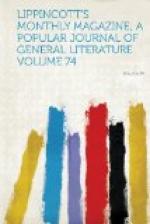which he saw. For the statements of the general
battle reference is made to official reports, as
follows: (1) In regard to the first day’s
battle, see report of General W.S. Rosecrans,
which may be found in vol. vii. of Putnam’s
Rebellion Record, p. 222 and following pages.
(2) In regard to the complete isolation of the
four divisions of the left during the second day,
and the final opening of communication with General
Thomas, see General W.B. Hazen’s official
report on p. 238 of the volume above quoted.
The writer also quotes, by permission, from letters from Generals Hazen and Thomas J. Wood, addressed to him within the present year. General Hazen says: “Do not forget about the length of time Thomas was cut off from us—how we could hear nothing from him; how neither Reynolds nor Palmer would assume command,” etc. General Wood says, in reference to the great disaster on the second day: “About 11 A.M. I received the following order from General Rosecrans: ’The commanding general directs that you close up on Reynolds as fast as possible, and support him.’ As there was an entire division (Brannan’s) between my division and Reynolds, I could only close upon the latter and support him by withdrawing my division from line and passing in rear of Brannan to the rear of Reynolds. This I did. Of course I knew it was an order involving perhaps the most momentous consequences, but General McCook concurred with me that it was so emphatic and positive as to demand instant obedience. I write you stubborn facts, and you can use them as such.”
General Wood has been so severely criticised for his obedience to this fatal order that perhaps I should add this further explanation, contained in the letter from which I have quoted above: “After the battle was over, and it was apparent that Rosecrans’s ill-considered order had led to a disaster, he offered as an explanation of it the statement that some staff-officer had reported to him that Brannan was out of line, and that he intended I should close to the left on Reynolds, and that I overlooked this direction to close to the left on Reynolds. Certainly, I overlooked it, or rather I did not see it, for it was not there to be seen. On the contrary, I was ordered to close up on Reynolds, and for a purpose—viz., to support him. I remark also that it was impossible for any man, on reading Rosecrans’s order to me, to even remotely conjecture that it was based on the supposition that Brannan was out of line. He had previously ordered me to rest my left on Brannan’s right, and I had reported to him that I had done so. Colonel Starling (of Crittenden’s staff) testified before the McCook-Crittenden court of inquiry that he was with Rosecrans at the time the latter directed the order to be sent to me, and told him that Brannan was not out of line.”




